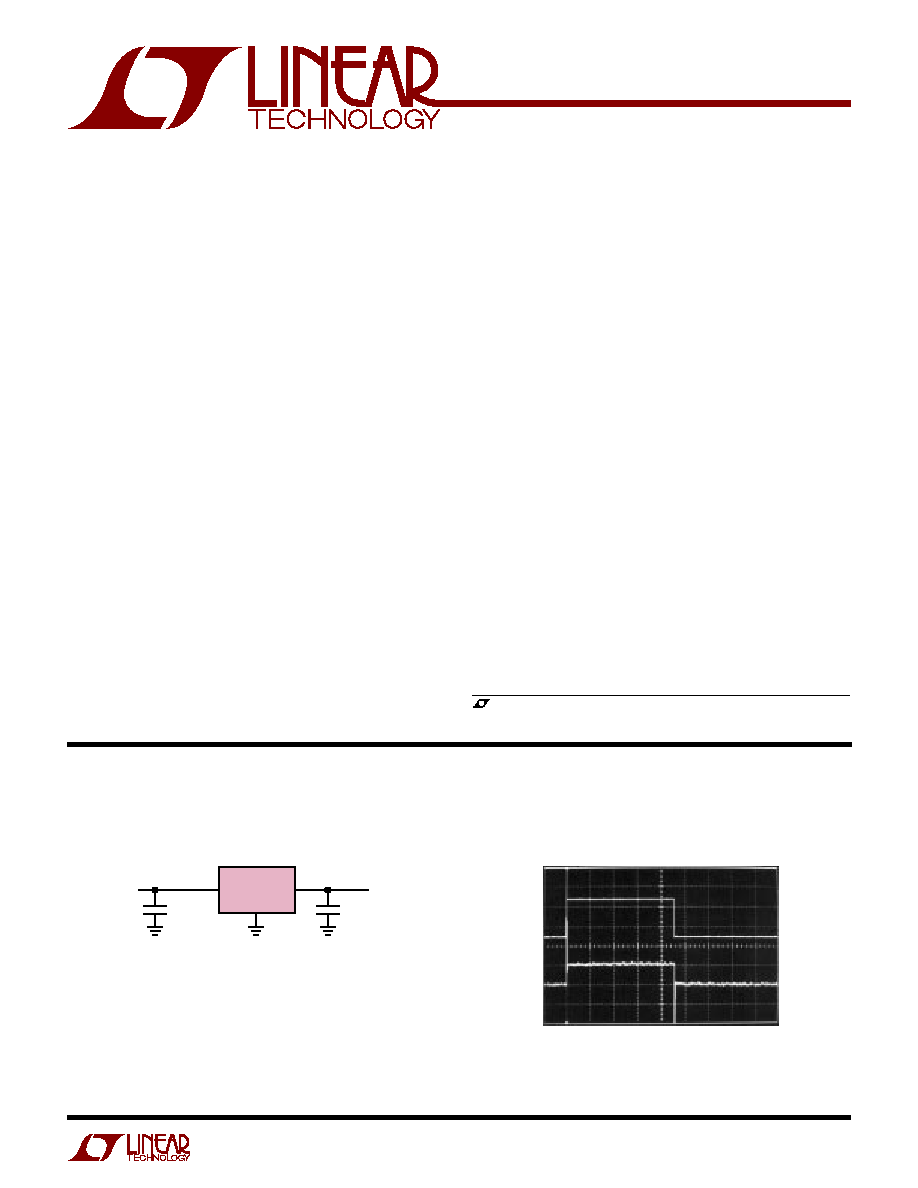
1
LT1461
Micropower Precision
Low Dropout Series
Voltage Reference Family
s
Trimmed to High Accuracy: 0.04% Max
s
Low Drift: 3ppm/
∞
C Max
s
Low Supply Current: 50
µ
A Max
s
Temperature Coefficient Guaranteed to 125
∞
C
s
High Output Current: 50mA Min
s
Low Dropout Voltage: 300mV Max
s
Excellent Thermal Regulation
s
Power Shutdown
s
Thermal Limiting
s
Operating Temperature Range: ≠ 40
∞
C to 125
∞
C
s
Voltage Options: 2.5V, 3V, 3.3V, 4.096V and 5V
The LT
Æ
1461 is a family of low dropout micropower bandgap
references that combine very high accuracy and low drift with
low supply current and high output drive. These series
references use advanced curvature compensation techniques
to obtain low temperature coefficient and trimmed precision
thin-film resistors to achieve high output accuracy. The
LT1461 family draws only 35
µ
A of supply current, making
them ideal for low power and portable applications, however
their high 50mA output drive makes them suitable for higher
power requirements, such as precision regulators.
In low power applications, a dropout voltage of less than
300mV ensures maximum battery life while maintaining full
reference performance. Line regulation is nearly immeasur-
able, while the exceedingly good load and thermal regulation
will not add significantly to system error budgets. The
shutdown feature can be used to switch full load currents and
can be used for system power down. Thermal shutdown
protects the part from overload conditions. The LT1461 is
available in 2.5V, 3V, 3.3V 4.096V and 5V options.
s
A/D and D/A Converters
s
Precision Regulators
s
Handheld Instruments
s
Power Supplies
, LTC and LT are registered trademarks of Linear Technology Corporation.
C
IN
1
µ
F
V
OUT
(V
OUT
+ 0.3V)
V
IN
20V
C
L
2
µ
F
1461 TA01
LT1461
LT1461-2.5 Load Regulation, P
DISS
= 200mW
Basic Connection
0mA
I
OUT
20mA
V
OUT
LOAD REG
1mV/DIV
10ms/DIV
1461 TA02
FEATURES
DESCRIPTIO
U
APPLICATIO S
U
TYPICAL APPLICATIO
U
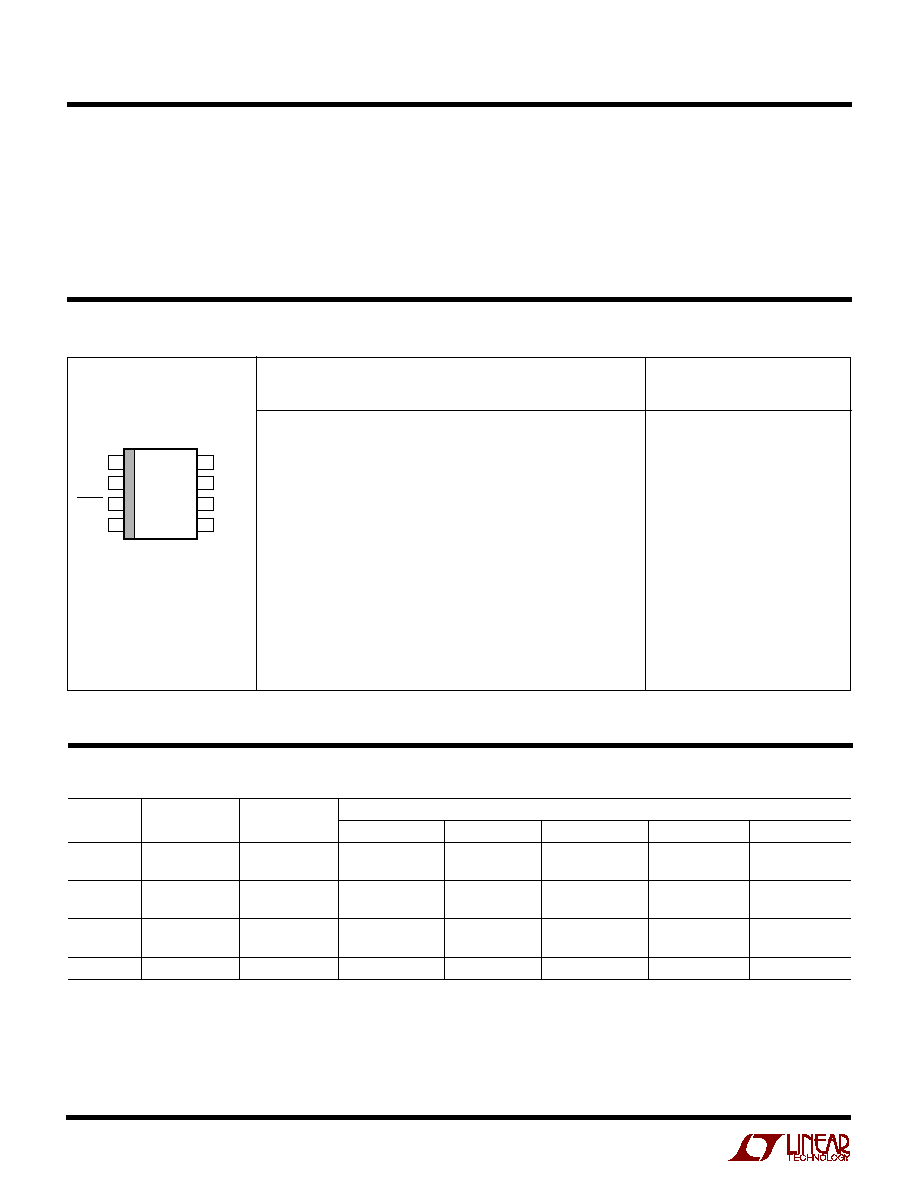
2
LT1461
ORDER PART
NUMBER
T
JMAX
= 150
∞
C,
JA
= 190
∞
C/ W
(Note 3)
1
2
3
4
8
7
6
5
TOP VIEW
*DNC: DO NOT CONNECT
DNC*
DNC*
V
OUT
DNC*
DNC*
V
IN
SHDN
GND
S8 PACKAGE
8-LEAD PLASTIC SO
Consult factory for Military grade parts.
Input Voltage ........................................................... 20V
Output Short-Circuit Duration ......................... Indefinite
Operating Temperature Range
(Note 2) ........................................... ≠ 40
∞
C to 125
∞
C
Storage Temperature Range (Note 3) ... ≠ 65
∞
C to 150
∞
C
ABSOLUTE AXI U RATI GS
W
W
W
U
Specified Temperature Range
Commercial ............................................ 0
∞
C to 70
∞
C
Industrial ........................................... ≠ 40
∞
C to 85
∞
C
High ................................................. ≠ 40
∞
C to 125
∞
C
Lead Temperature (Soldering, 10 sec).................. 300
∞
C
(Note 1)
LT1461ACS8-2.5
LT1461BCS8-2.5
LT1461CCS8-2.5
LT1461AIS8-2.5
LT1461BIS8-2.5
LT1461CIS8-2.5
LT1461DHS8-2.5
LT1461ACS8-3
LT1461BCS8-3
LT1461CCS8-3
LT1461AIS8-3
LT1461BIS8-3
LT1461CIS8-3
LT1461DHS8-3
461A25
461B25
461C25
61AI25
61BI25
61CI25
61DH25
1461A3
1461B3
1461C3
461AI3
461BI3
461CI3
461DH3
LT1461ACS8-3.3
LT1461BCS8-3.3
LT1461CCS8-3.3
LT1461AIS8-3.3
LT1461BIS8-3.3
LT1461CIS8-3.3
LT1461DHS8-3.3
LT1461ACS8-4
LT1461BCS8-4
LT1461CCS8-4
LT1461AIS8-4
LT1461BIS8-4
LT1461CIS8-4
LT1461DHS8-4
LT1461ACS8-5
LT1461BCS8-5
LT1461CCS8-5
LT1461AIS8-5
LT1461BIS8-5
LT1461CIS8-5
LT1461DHS8-5
S8 PART MARKING
AVAILABLE OPTIO S
U
INITIAL
TEMPERATURE
TEMPERATURE
OUTPUT VOLTAGE
ACCURACY
COEFFICIENT
RANGE
2.5V
3.0V
3.3V
4.096V
5.0V
0.04% Max
3ppm/
∞
C Max
0
∞
C to 70
∞
C
LT1461ACS8-2.5
LT1461ACS8-3
LT1461ACS8-3.3
LT1461ACS8-4
LT1461ACS8-5
0.04% Max
3ppm/
∞
C Max
≠ 40
∞
C to 85
∞
C
LT1461AIS8-2.5
LT1461AIS8-3
LT1461AIS8-3.3
LT1461AIS8-4
LT1461AIS8-5
0.06% Max
7ppm/
∞
C Max
0
∞
C to 70
∞
C
LT1461BCS8-2.5
LT1461BCS8-3
LT1461BCS8-3.3
LT1461BCS8-4
LT1461BCS8-5
0.06% Max
7ppm/
∞
C Max
≠ 40
∞
C to 85
∞
C
LT1461BIS8-2.5
LT1461BIS8-3
LT1461BIS8-3.3
LT1461BIS8-4
LT1461BIS8-5
0.08% Max
12ppm/
∞
C Max
0
∞
C to 70
∞
C
LT1461CCS8-2.5
LT1461CCS8-3
LT1461CCS8-3.3
LT1461CCS8-4
LT1461CCS8-5
0.08% Max
12ppm/
∞
C Max
≠ 40
∞
C to 85
∞
C
LT1461CIS8-2.5
LT1461CIS8-3
LT1461CIS8-3.3
LT1461CIS8-4
LT1461CIS8-5
0.15% Max
20ppm/
∞
C Max
≠40
∞
C to 125
∞
C
LT1461DHS8-2.5
LT1461DHS8-3
LT1461DHS8-3.3
LT1461DHS8-4
LT1461DHS8-5
461A33
461B33
461C33
61AI33
61BI33
61CI33
61DH33
1461A4
1461B4
1461C4
461AI4
461BI4
461CI4
461DH4
1461A5
1461B5
1461C5
461AI5
461BI5
461CI5
461DH5
PACKAGE/ORDER I FOR ATIO
U
U
W

3
LT1461
PARAMETER
CONDITIONS
MIN
TYP
MAX
UNITS
Output Voltage (Note 4)
LT1461ACS8/LT1461AIS8
≠ 0.04
0.04
%
LT1461BCS8/LT1461BIS8
≠ 0.06
0.06
%
LT1461CCS8/LT1461CIS8
≠ 0.08
0.08
%
LT1461DHS8
≠ 0.15
0.15
%
Output Voltage Temperature Coefficient (Note 5)
LT1461ACS8/LT1461AIS8
q
1
3
ppm/
∞
C
LT1461BCS8/LT1461BIS8
q
3
7
ppm/
∞
C
LT1461CCS8/LT1461CIS8
q
5
12
ppm/
∞
C
LT1461DHS8
q
7
20
ppm/
∞
C
Line Regulation
(V
OUT
+ 0.5V)
V
IN
20V
2
8
ppm/V
q
12
ppm/V
LT1461DHS8
q
15
50
ppm/V
Load Regulation Sourcing (Note 6)
V
IN
= V
OUT
+ 2.5V
0
I
OUT
50mA
12
30
ppm/mA
q
40
ppm/mA
LT1461DHS8, 0
I
OUT
10mA
q
50
ppm/mA
Dropout Voltage
V
IN
≠ V
OUT
, V
OUT
Error = 0.1%
I
OUT
= 0mA
0.06
V
I
OUT
= 1mA
q
0.13
0.3
V
I
OUT
= 10mA
q
0.20
0.4
V
I
OUT
= 50mA, I and C Grades Only
q
1.50
2.0
V
Output Current
Short V
OUT
to GND
100
mA
Shutdown Pin
Logic High Input Voltage
q
2.4
V
Logic High Input Current, Pin 3 = 2.4V
q
2
15
µ
A
Logic Low Input Voltage
q
0.8
V
Logic Low Input Current, Pin 3 = 0.8V
q
0.5
4
µ
A
Supply Current
No Load
35
50
µ
A
q
70
µ
A
Shutdown Current
R
L
= 1k
25
35
µ
A
q
55
µ
A
Output Voltage Noise (Note 7)
0.1Hz
f
10Hz
8
ppm
P-P
10Hz
f
1kHz
9.6
ppm
RMS
Long-Term Drift of Output Voltage, SO-8 Package (Note 8)
See Applications Information
60
ppm/
kHr
Thermal Hysteresis (Note 9)
T = 0
∞
C to 70
∞
C
40
ppm
T = ≠ 40
∞
C to 85
∞
C
75
ppm
T = ≠ 40
∞
C to 125
∞
C
120
ppm
The
q
denotes specifications which apply over the specified temperature
range, otherwise specifications are at T
A
= 25
∞
C. V
IN
≠ V
OUT
= 0.5V, Pin 3 = 2.4V, C
L
= 2
µ
F, unless otherwise specified.
ELECTRICAL CHARACTERISTICS
Note 1: Absolute Maximum Ratings are those values beyond which the life
of a device may be impaired.
Note 2: The LT1461 is guaranteed functional over the operating
temperature range of ≠ 40
∞
C to 125
∞
C.
Note 3: If the part is stored outside of the specified temperature range, or
the junction temperature exceeds the specified temperature range, the
output may shift due to hysteresis.
Note 4: ESD (Electrostatic Discharge) sensitive device. Extensive use of
ESD protection devices are used internal to the LT1461, however, high
electrostatic discharge can damage or degrade the device. Use proper ESD
handling precautions.
Note 5: Temperature coefficient is calculated from the minimum and
maximum output voltage measured at T
MIN
, Room and T
MAX
as follows:
TC = (V
OMAX
≠ V
OMIN
)/(T
MAX
≠ T
MIN
)
Incremental slope is also measured at 25
∞
C.
Note 6: Load regulation is measured on a pulse basis from no load to the
specified load current. Output changes due to die temperature change
must be taken into account separately.
Note 7: Peak-to-peak noise is measured with a single pole highpass filter
at 0.1Hz and a 2-pole lowpass filter at 10Hz. The unit is enclosed in a still-
air environment to eliminate thermocouple effects on the leads. The test
time is 10 seconds. RMS noise is measured with a single pole highpass
filter at 10Hz and a 2-pole lowpass filter at 1kHz. The resulting output is
full-wave rectified and then integrated for a fixed period, making the final
reading an average as opposed to RMS. A correction factor of 1.1 is used
to convert from average to RMS and a second correction of 0.88 is used to
correct for the nonideal bandpass of the filters.

4
LT1461
ELECTRICAL CHARACTERISTICS
Note 8: Long-term drift typically has a logarithmic characteristic and
therefore, changes after 1000 hours tend to be much smaller than before
that time. Total drift in the second thousand hours is normally less than
one third that of the first thousand hours with a continuing trend toward
reduced drift with time. Long-term drift will also be affected by differential
stresses between the IC and the board material created during board
assembly. See the Applications Information section.
Note 9: Hysteresis in output voltage is created by package stress that
depends on whether the IC was previously at a higher or lower
temperature. Output voltage is always measured at 25
∞
C, but the IC is
cycled hot or cold before successive measurements. Hysteresis is roughly
proportional to the square of the temperature change. Hysteresis is not
normally a problem for operational temperature excursions where the
instrument might be stored at high or low temperature. See Applications
Information section.
TEMPERATURE (
∞
C)
≠ 60 ≠ 40 ≠ 20
2.4980
REFERENCE VOLTAGE (V)
2.4985
2.4995
2.5000
2.5005
60
80 100
1461 G01
2.4990
0
20
40
120
2.5010
2.5015
2.5020
TEMPCO ≠60
∞
C TO 120
∞
C
3 TYPICAL PARTS
2.5V Reference Voltage
vs Temperature
TEMPERATURE (
∞
C)
≠40 ≠ 20
LINE REGULATION (ppm/V)
≠ 4
≠ 2
120
1461 G03
≠ 6
≠ 8
0
40
80
100
20
60
0
≠ 5
≠ 3
≠7
≠1
SUPPLY
= 15V
5V ≠ 20V
2.5V Line Regulation
vs Temperature
2.5V Load Regulation
OUTPUT CURRENT (mA)
0.1
800
OUTPUT VOLTAGE CHANGE (ppm)
1200
1600
1
10
100
1461 G02
400
0
125
∞
C
25
∞
C
≠ 55
∞
C
V
IN
= 7.5V
TYPICAL PERFOR A CE CHARACTERISTICS
U
W
Characteristic curves are similar for most LT1461s.
Curves from the LT1461-2.5 and the LT1461-5 represent the extremes of the voltage options. Characteristic curves for other output
voltages fall between these curves and can be estimated based on their output.
2.5V Ripple Rejection Ratio
vs Frequency
2.5V Minimum Input/Output
Voltage Differential vs Load Current
OUTPUT CURRENT (mA)
0.1
0.1
INPUT/OUTPUT VOLTAGE (V)
1
10
1
10
100
1461 G04
≠ 55
∞
C
25
∞
C
125
∞
C
2.5V Supply Current
vs Input Voltage
INPUT VOLTAGE (V)
SUPPLY CURRENT (
µ
A)
1000
1461 G05
10
100
5
25
20
15
10
0
125
∞
C
≠ 55
∞
C
25
∞
C
FREQUENCY (kHz)
0.01
40
RIPPLE REJECTION RATIO (dB)
50
60
70
80
0.1
1
100
10
1000
1641 G06
30
20
10
0
90
100
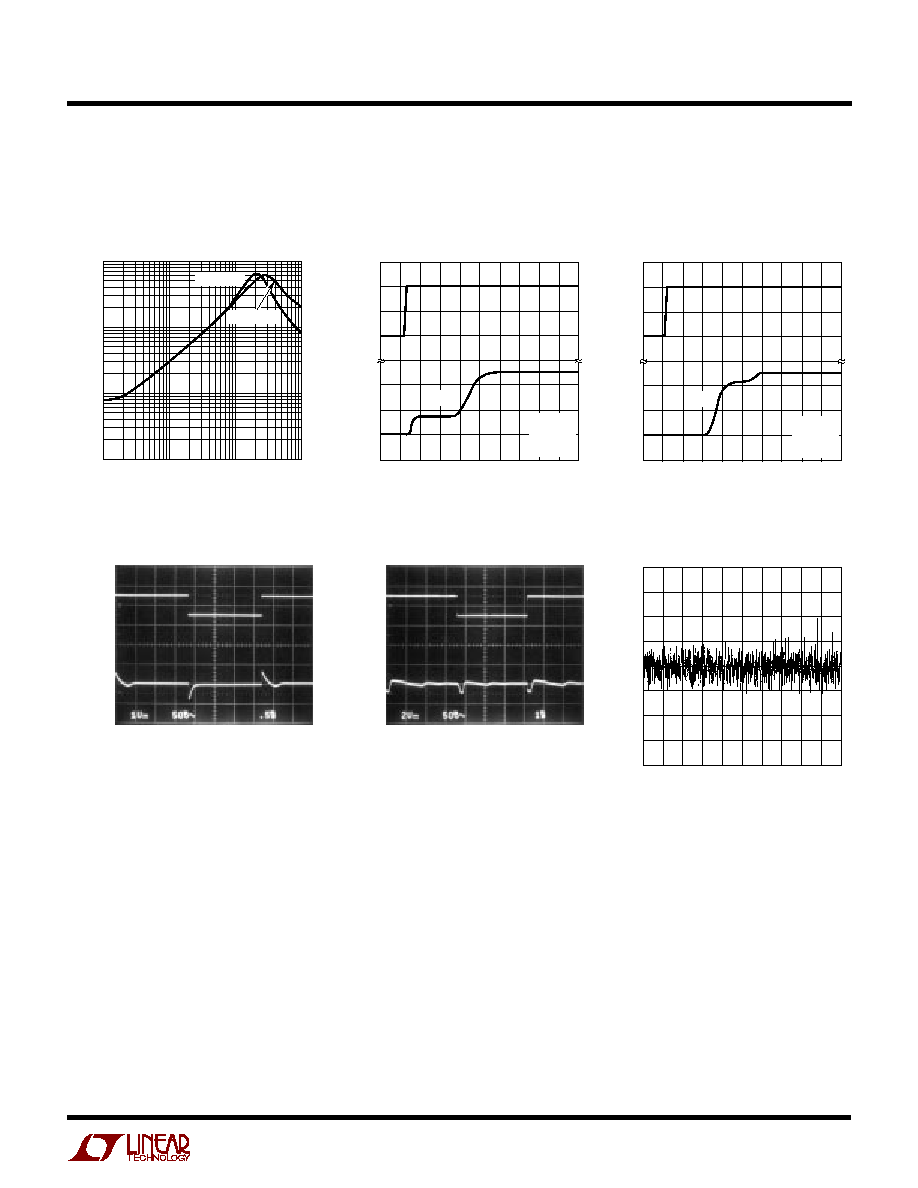
5
LT1461
2.5V Turn-On Time
2.5V Output Impedance
vs Frequency
2.5V Turn-On Time
FREQUENCY (kHz)
0.01
1
OUTPUT IMPEDANCE (
)
10
100
1000
0.1
1
10
1461 G07
C
OUT
= 2
µ
F
C
OUT
= 1
µ
F
TIME (100
µ
s/DIV)
VOLTAGE (V)
V
IN
20
10
0
2
1
0
1461 G08
C
IN
= 1
µ
F
C
L
= 2
µ
F
R
L
=
V
OUT
TIME (100
µ
s/DIV)
VOLTAGE (V)
V
IN
20
10
0
2
1
0
1461 G09
C
IN
= 1
µ
F
C
L
= 2
µ
F
R
L
= 50
V
OUT
TYPICAL PERFOR A CE CHARACTERISTICS
U
W
Characteristic curves are similar for most LT1461s.
Curves from the LT1461-2.5 and the LT1461-5 represent the extremes of the voltage options. Characteristic curves for other output
voltages fall between these curves and can be estimated based on their output.
2.5V Transient Response to 10mA
Load Step
I
OUT
0mA
10mA/DIV
V
OUT
50mV/DIV
1461 G10
2.5V Line Transient Response
5V
V
IN
V
OUT
50mV/DIV
1461 G11
C
IN
= 0.1
µ
F
2.5V Output Noise
0.1Hz
f
10Hz
C
L
= 2
µ
F
TIME (2SEC/DIV)
OUTPUT NOISE (10
µ
V/DIV)
1461 G12
4V
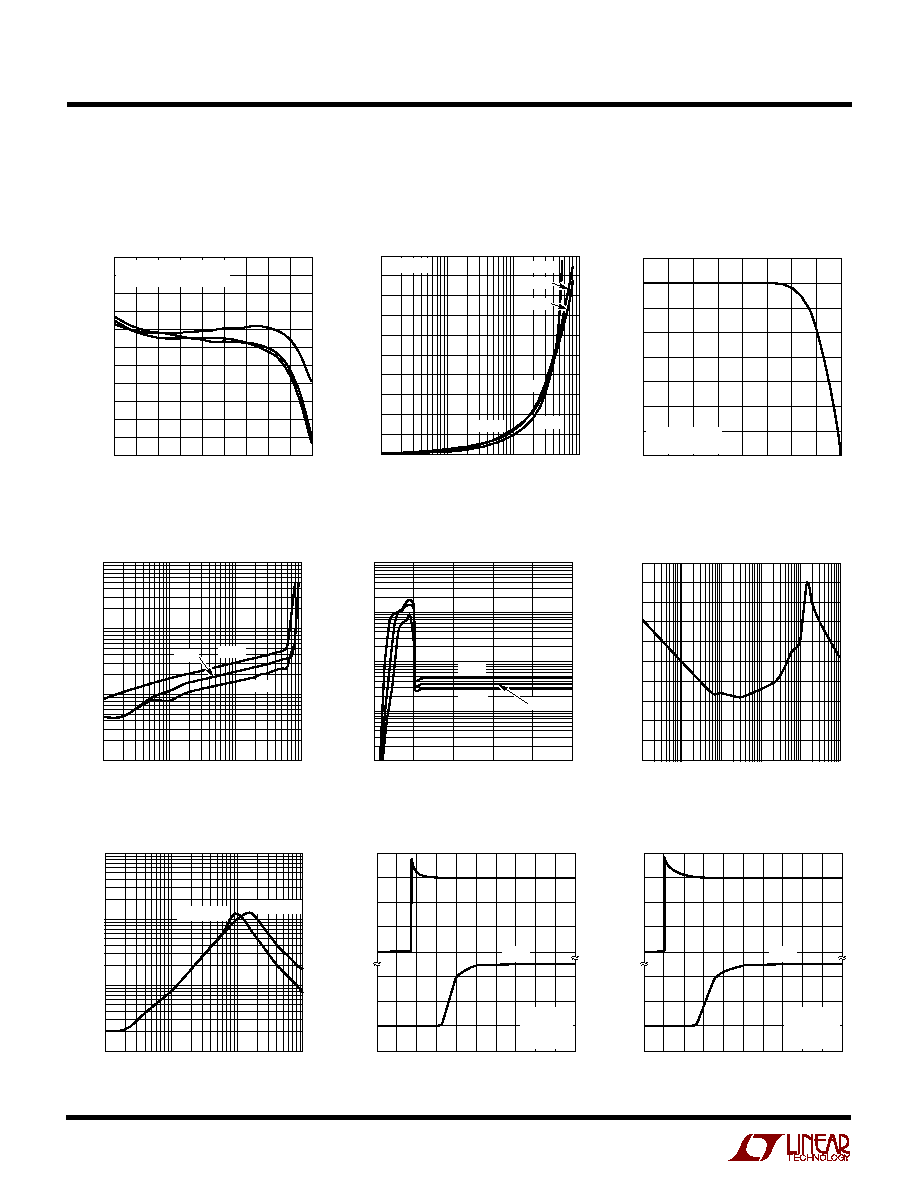
6
LT1461
TYPICAL PERFOR A CE CHARACTERISTICS
U
W
Characteristic curves are similar for most LT1461s.
Curves from the LT1461-2.5 and the LT1461-5 represent the extremes of the voltage options. Characteristic curves for other output
voltages fall between these curves and can be estimated based on their output.
5V Reference Voltage
vs Temperature
5V Line Regulation
vs Temperature
5V Load Regulation
5V Ripple Rejection Ratio
vs Frequency
5V Minimum Input/Output Voltage
Differential vs Load Current
5V Supply Current
vs Input Voltage
TEMPERATURE (
∞
C)
≠60
REFERENCE VOLTAGE (V)
5.0040
5.0030
5.0020
5.0010
5.0000
4.9990
4.9980
4.9970
4.9960
4.9950
4.9940
4.9930
≠20
20
40
1461 G13
≠40
0
60
80 100 120
TEMPCO ≠60
∞
C TO 120
∞
C
3 TYPICAL PARTS
OUTPUT CURRENT (mA)
0.1
800
LOAD REGULATION (ppm)
1200
1600
1
10
100
1461 G14
400
0
2000
V
IN
= 10V
125
∞
C
125
∞
C
25
∞
C
25
∞
C
≠55
∞
C
≠55
∞
C
TEMPERATURE (
∞
C)
≠40
LINE REGULATION (ppm
/
V
)
≠4
≠2
120
1461 G15
≠6
≠8
0
40
80
≠20
20
60
100
0
≠5
≠3
≠7
≠1
SUPPLY
= 14V
6V TO 20V
OUTPUT CURRENT (mA)
0.1
0.01
INPUT/OUTPUT VOLTAGE (V)
0.1
1
10
1
10
100
1461 G16
125
∞
C
≠55
∞
C
25
∞
C
INPUT VOLTAGE (V)
10
SUPPLY CURRENT (
µ
A)
100
1000
10000
0
10
15
20
1
5
25
1461 G17
125
∞
C
≠55
∞
C
25
∞
C
FREQUENCY (kHz)
0.01
40
RIPPLE REJECTION RATIO (dB)
50
60
70
80
0.1
1
10
100
1000
1461 G18
30
20
10
0
90
100
5V Output Impedance vs Frequency
5V Turn-On Time
FREQUENCY (kHz)
0.01
1
OUTPUT IMPEDANCE (
)
10
100
1000
0.1
1
10
1461 G19
C
OUT
= 2
µ
F
C
OUT
= 1
µ
F
200
µ
s/DIV
V
IN
2V/DIV
6
4
2
0
4
2
0
1461 G20
V
OUT
C
IN
= 1
µ
F
C
OUT
= 2
µ
F
I
OUT
= 0
200
µ
s/DIV
V
IN
2V/DIV
6
4
2
0
4
2
0
1461 G21
V
OUT
C
IN
= 1
µ
F
C
OUT
= 2
µ
F
I
OUT
= 50mA
5V Turn-On Time

7
LT1461
TYPICAL PERFOR A CE CHARACTERISTICS
U
W
Characteristic curves are similar for most LT1461s.
Curves from the LT1461-2.5 and the LT1461-5 represent the extremes of the voltage options. Characteristic curves for other output
voltages fall between these curves and can be estimated based on their output.
5V Transient Response to 10mA
Load Step
I
OUT
V
OUT
50mV/DIV
1461 G22
5V Line Transient Response
5V Output Noise
0.1Hz
f
10Hz
C
L
= 2
µ
F
0mA
10mA
Supply Current
vs Temperature
Current Limit vs Temperature
SHDN Pin Current
vs SHDN Input Voltage
V
IN
V
OUT
50mV/DIV
1461 G23
C
IN
= 0.1
µ
F
7V
6V
TIME (2SEC/DIV)
OUTPUT NOISE (10
µ
V/DIV)
1461 G24
TEMPERATURE (
∞
C)
≠ 40
SUPPLY CURRENT (
µ
A)
30
40
50
I
S
20
60
120
1461 G25
20
10
0
≠20
0
40
80
100
I
S(SHDN)
TEMPERATURE (
∞
C)
≠50
≠25
40
CURRENT LIMIT (mA)
80
140
0
50
75
1461 G26
60
120
100
25
100
125
SHDN PIN INPUT VOLTAGE (V)
0
0
SHDN PIN CURRENT (
µ
A)
20
60
80
100
200
140
10
1461 G27
40
160
125
∞
C
≠ 55
∞
C
180
120
5
15
20
25
∞
C
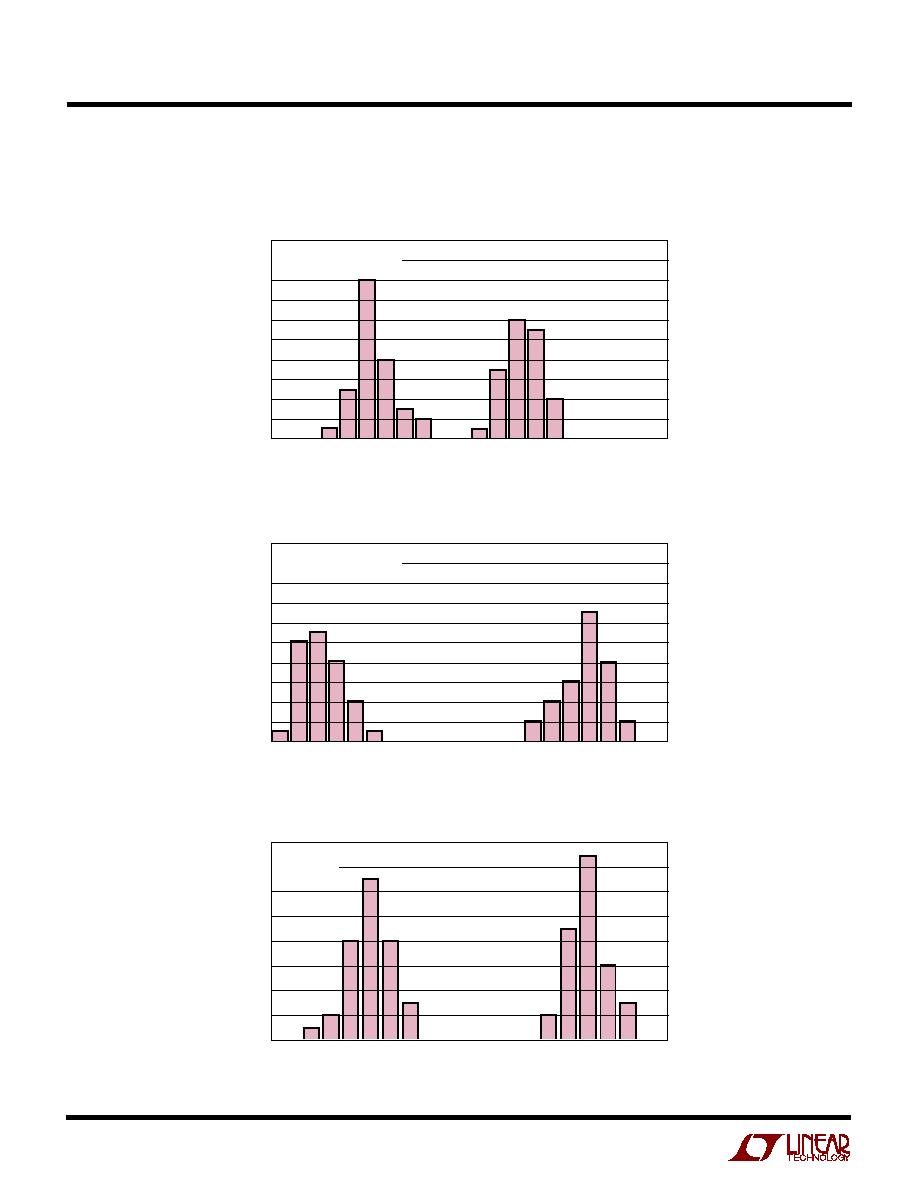
8
LT1461
HYSTERESIS (ppm)
≠200
NUMBER OF UNITS
12
16
WORST-CASE HYSTERESIS
ON 35 UNITS
8
4
10
14
6
2
0
≠160
≠120
≠80
≠40
0
40
80
120
160
200
≠ 40
∞
C TO 25
∞
C
125
∞
C TO 25
∞
C
1461 G31
HYSTERESIS (ppm)
≠100
NUMBER OF UNITS
12
16
20
WORST-CASE HYSTERESIS
ON 35 UNITS
8
4
10
14
18
6
2
0
≠ 80
≠ 60
≠ 40
≠ 20
0
20
40
60
80
100
≠ 40
∞
C TO 25
∞
C
85
∞
C TO 25
∞
C
1461 G30
HYSTERESIS (ppm)
≠100
NUMBER OF UNITS
12
16
20
WORST-CASE HYSTERESIS
ON 35 UNITS
1461 G29
8
4
10
14
18
6
2
0
≠ 80
≠ 60
≠ 40
0
∞
C TO 25
∞
C
70
∞
C TO 25
∞
C
≠ 20
0
20
40
60
80
100
≠ 40
∞
C to 85
∞
C Hysteresis
≠ 40
∞
C to 125
∞
C Hysteresis
0
∞
C to 70
∞
C Hysteresis
TYPICAL PERFOR A CE CHARACTERISTICS
U
W
Characteristic curves are similar for most LT1461s.
Curves from the LT1461-2.5 and the LT1461-5 represent the extremes of the voltage options. Characteristic curves for other output
voltages fall between these curves and can be estimated based on their output.
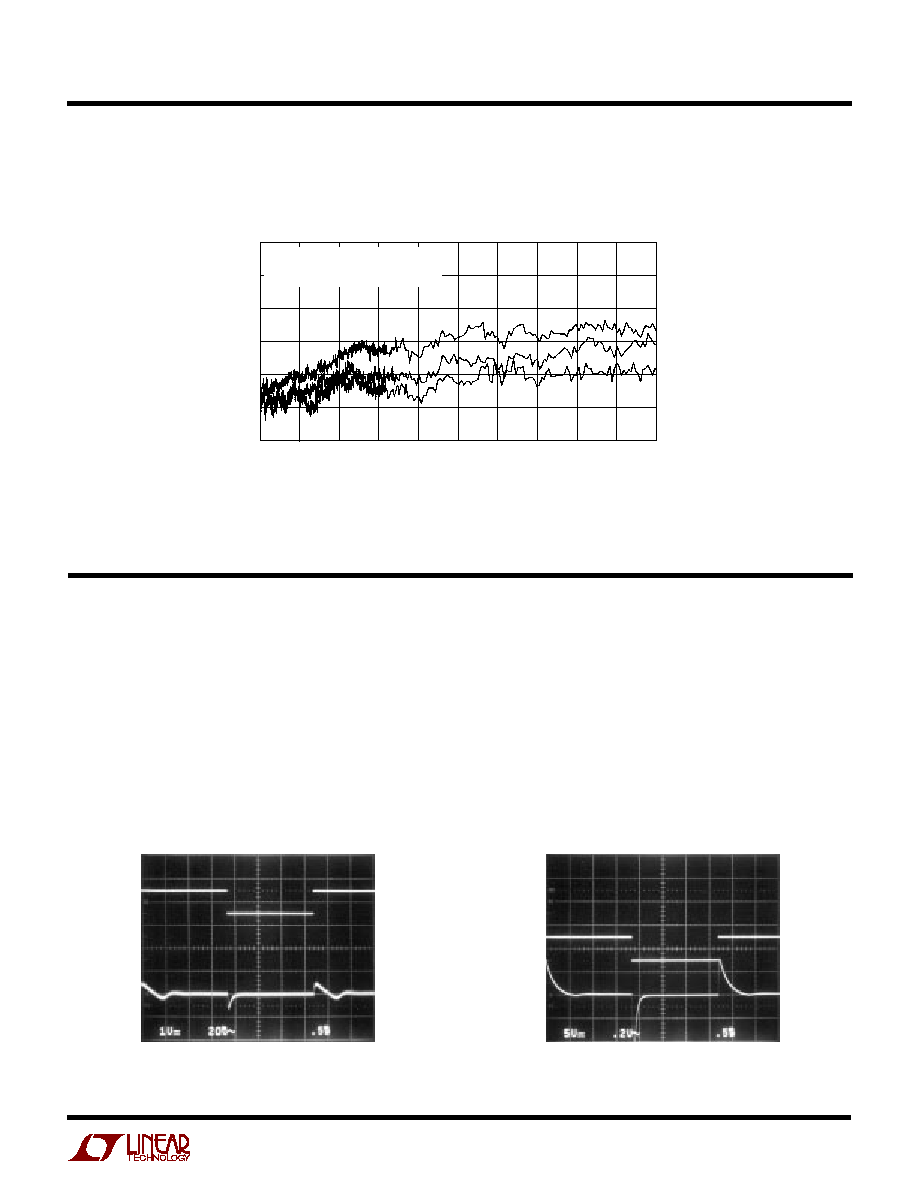
9
LT1461
APPLICATIO S I FOR ATIO
W
U
U
U
Examples shown in this Applications section use the
LT1461-2.5. The response of other voltage options can
be estimated by proper scaling.
Bypass and Load Capacitors
The LT1461 family requires a capacitor on the input and
on the output for stability. The capacitor on the input is a
supply bypass capacitor and if the bypass capacitors
from other components are close (within 2 inches) they
*SEE APPLICATIONS INFORMATION FOR DETAILED EXPLANATION OF LONG-TERM DRIFT
Long-Term Drift (Number of Data Points Reduced at 650 Hours)*
TYPICAL PERFOR A CE CHARACTERISTICS
U
W
Characteristic curves are similar for most LT1461s.
Curves from the LT1461-2.5 and the LT1461-5 represent the extremes of the voltage options. Characteristic curves for other output
voltages fall between these curves and can be estimated based on their output.
HOURS
≠50
ppm
50
150
250
0
100
200
400
800
1200
1600
1461 G15
2000
200
600
1000
1400
1800
0
LT1461S8
3 TYPICAL PARTS SOLDERED ONTO PCB
T
A
= 30
∞
C
V
OUT
200mV/DIV
1461 F02
Figure 2. 50mA Load Step with C
L
= 2
µ
F
I
OUT
50mA/DIV
0mA
1mA
I
OUT
1mA/DIV
V
OUT
20mV/DIV
1461 F01
Figure 1. 1mA Load Step with C
L
= 1
µ
F
should be sufficient. The output capacitor acts as fre-
quency compensation for the reference and cannot be
omitted. For light loads
1mA, a 1
µ
F nonpolar output
capacitor is usually adequate, but for higher loads (up to
75mA), the output capacitor should be 2
µ
F or greater.
Figures 1 and 2 show the transient response to a 1mA
load step with a 1
µ
F output capacitor and a 50mA load
step with a 2
µ
F output capacitor.
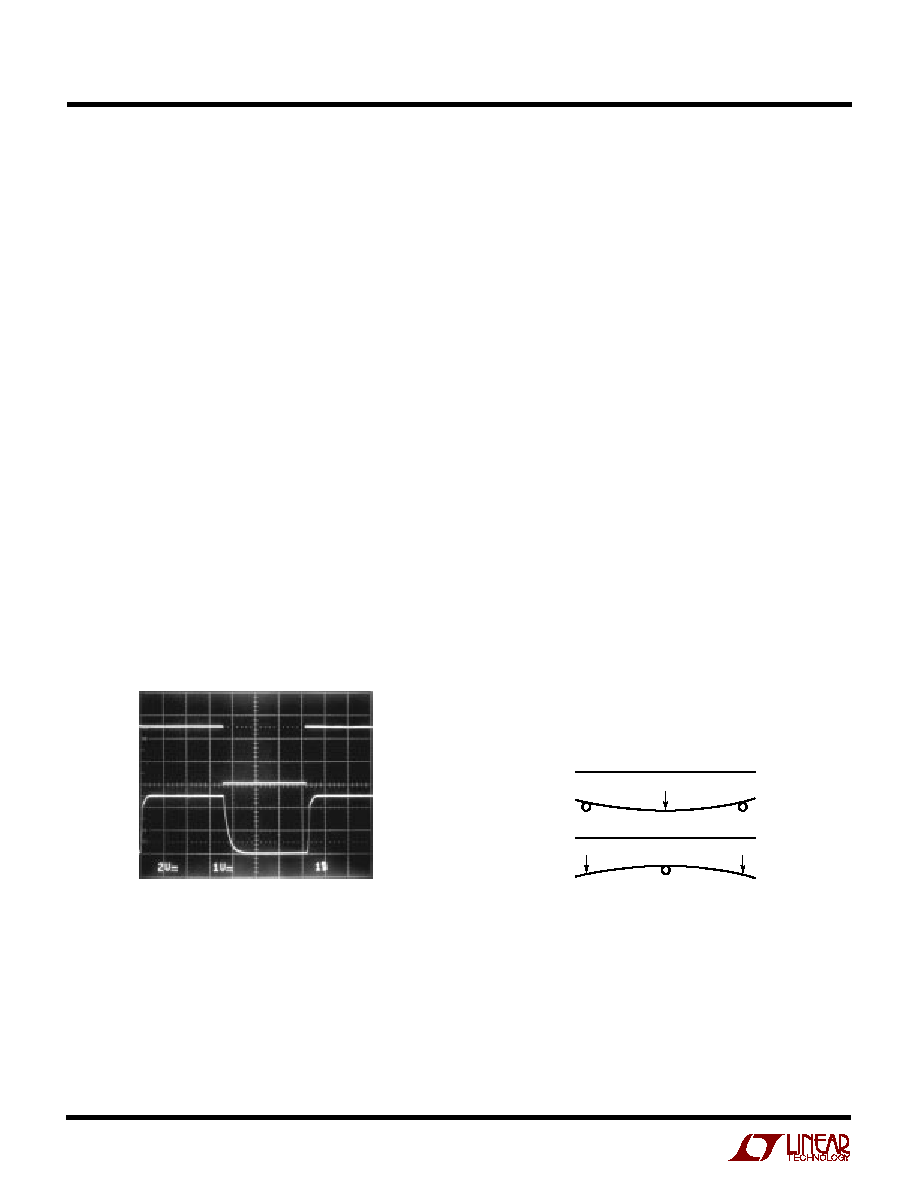
10
LT1461
Precision Regulator
The LT1461 will deliver 50mA with V
IN
= V
OUT
+ 2.5V and
higher load current with higher V
IN
. Load regulation is
typically 12ppm/mA, which means for a 50mA load step,
the output will change by only 1.5mV. Thermal regulation,
caused by die temperature gradients and created from
load current or input voltage changes, is not measurable.
This often overlooked parameter must be added to normal
line and load regulation errors. The load regulation photo,
on the first page of this data sheet, shows the output
response to 200mW of instantaneous power dissipation
and the reference shows no sign of thermal errors. The
reference has thermal shutdown and will turn off if the
junction temperature exceeds 150
∞
C.
Shutdown
The shutdown (Pin 3 low) serves to shut off load current
when the LT1461 is used as a regulator. The LT1461
operates normally with Pin 3 open or greater than or equal
to 2.4V. In shutdown, the reference draws a maximum
supply current of 35
µ
A. Figure 3 shows the transient
response of shutdown while the part is delivering 25mA.
After shutdown, the reference powers up in about 200
µ
s.
5V
1461 F03
Figure 3. Shutdown While Delivering 25mA, R
L
= 100
0V
PIN 3
0V
V
OUT
PC Board Layout
In 13- to 16-bit systems where initial accuracy and tem-
perature coefficient calibrations have been done, the me-
chanical and thermal stress on a PC board (in a card cage
for instance) can shift the output voltage and mask the true
temperature coefficient of a reference. In addition, the
mechanical stress of being soldered into a PC board can
cause the output voltage to shift from its ideal value.
Surface mount voltage references are the most suscep-
tible to PC board stress because of the small amount of
plastic used to hold the lead frame.
A simple way to improve the stress-related shifts is to
mount the reference near the short edge of the PC board,
or in a corner. The board edge acts as a stress boundary,
or a region where the flexure of the board is minimum. The
package should always be mounted so that the leads
absorb the stress and not the package. The package is
generally aligned with the leads parallel to the long side of
the PC board as shown in Figure 5a.
A qualitative technique to evaluate the effect of stress on
voltage references is to solder the part into a PC board and
deform the board a fixed amount as shown in Figure 4. The
flexure #1 represents no displacement, flexure #2 is
concave movement, flexure #3 is relaxation to no dis-
placement and finally, flexure #4 is a convex movement.
This motion is repeated for a number of cycles and the
APPLICATIO S I FOR ATIO
W
U
U
U
1
2
3
4
1461 F04
Figure 4. Flexure Numbers
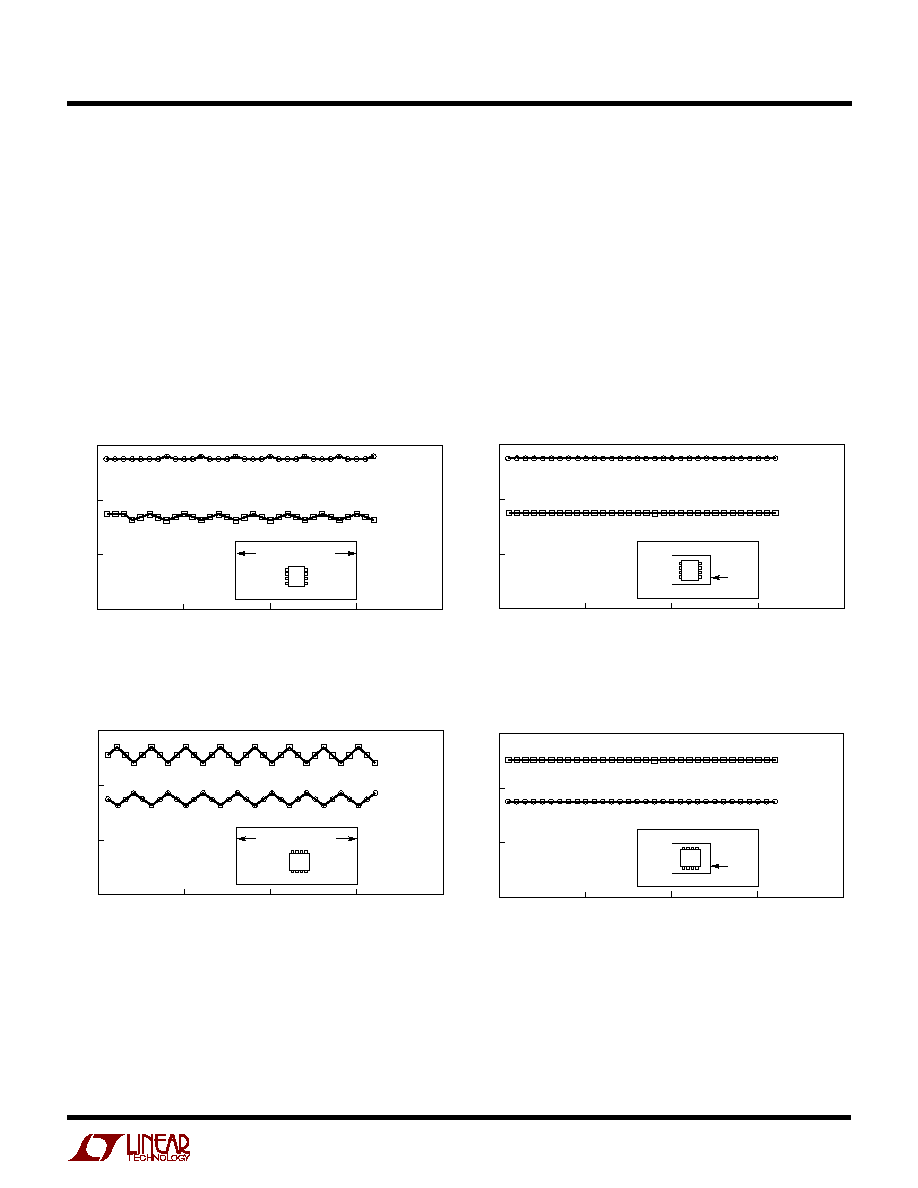
11
LT1461
The most effective technique to improve PC board stress
is to cut slots in the board around the reference to serve as
a strain relief. These slots can be cut on three sides of the
reference and the leads can exit on the fourth side. This
"tongue" of PC board material can be oriented in the long
direction of the board to further reduce stress transferred
to the reference.
The results of slotting the PC boards of Figures 5a and
5b are shown in Figures 6a and 6b. In this example the
slots can improve the output shift from about 100ppm to
nearly zero.
relative output deviation is noted. The result shown in
Figure 5a is for two LT1461S8-2.5s mounted vertically and
Figure 5b is for two LT1461S8-2.5s mounted horizontally.
The parts oriented in Figure 5a impart less stress into the
package because stress is absorbed in the leads. Figures
5a and 5b show the deviation to be between 125
µ
V and
250
µ
V and implies a 50ppm and 100ppm change respec-
tively. This corresponds to a 13- to 14-bit system and is
not a problem for most 10- to 12-bit systems unless the
system has a calibration. In this case, as with temperature
hysteresis, this low level can be important and even more
careful techniques are required.
SLOT
2
1
0
0
40
30
20
FLEXURE NUMBER
10
1461 F06a
≠1
OUTPUT DEVIATION (mV)
Figure 6a. Same Two LT1461S8-2.5s in Figure 5a, but with Slots
SLOT
2
1
0
0
40
30
20
FLEXURE NUMBER
10
1461 F06b
≠1
OUTPUT DEVIATION (mV)
Figure 6b. Same Two LT1461S8-2.5s in Figure 5b, but with Slots
LONG DIMENSION
2
1
0
0
40
30
20
FLEXURE NUMBER
10
1461 F05a
≠1
OUTPUT DEVIATION (mV)
Figure 5a. Two Typical LT1461S8-2.5s,
Vertical Orientation Without Slots
FLEXURE NUMBER
1461 F05b
LONG DIMENSION
2
1
0
0
40
30
20
10
≠1
OUTPUT DEVIATION (mV)
Figure 5b. Two Typical LT1461S8-2.5s,
Horizontal Orientation Without Slots
APPLICATIO S I FOR ATIO
W
U
U
U
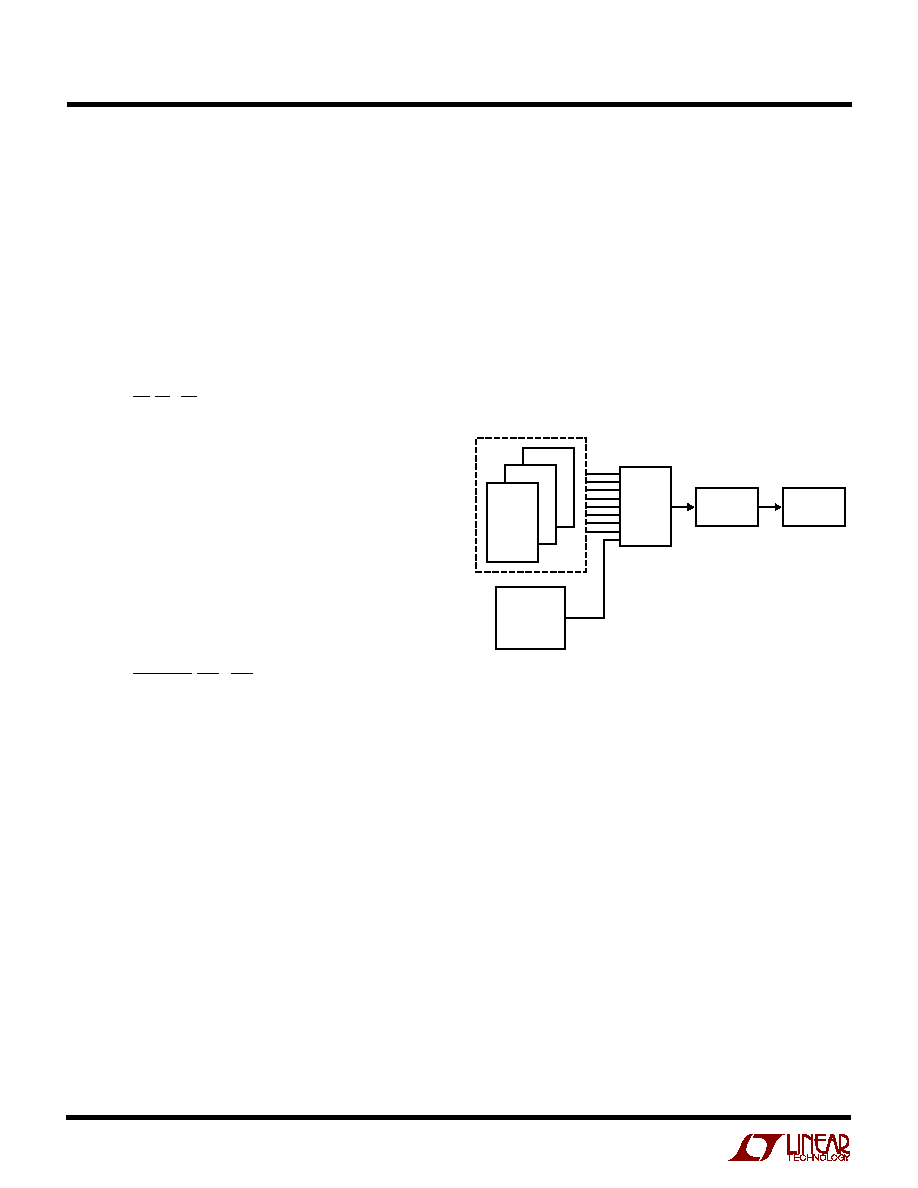
12
LT1461
Long-Term Drift
Long-term drift cannot be extrapolated from acceler-
ated high temperature testing. This erroneous technique
gives drift numbers that are wildly optimistic. The only
way long-term drift can be determined is to measure it
over the time interval of interest. The erroneous tech-
nique uses the Arrhenius Equation to derive an accelera-
tion factor from elevated temperature readings. The
equation is:
A
e
F
E
K T
T
A
=
1
1
1
2
≠
where: E
A
= Activation Energy (Assume 0.7)
K = Boltzmann's Constant
T2 = Test Condition in
∞
Kelvin
T1 = Use Condition Temperature in
∞
Kelvin
To show how absurd this technique is, compare the
LT1461 data. Typical 1000 hour long-term drift at 30
∞
C =
60ppm. The typical 1000 hour long-term drift at 130
∞
C =
120ppm. From the Arrhenius Equation the acceleration
factor is:
A
e
F
=
=
0 7
0 0000863
1
303
1
403
767
.
.
≠
The erroneous projected long-term drift is:
120ppm/767 = 0.156ppm/1000 hr
For a 2.5V reference, this corresponds to a 0.39
µ
V shift
after 1000 hours. This is pretty hard to determine (read
impossible) if the peak-to-peak output noise is larger than
this number. As a practical matter, one of the best labora-
tory references available is the Fluke 732A and its long-
term drift is 1.5
µ
V/mo. This performance is only available
from the best subsurface zener references utilizing spe-
cialized heater techniques.
The LT1461 long-term drift data was taken with parts that
were soldered onto PC boards similar to a "real world"
application. The boards were then placed into a constant
temperature oven with T
A
= 30
∞
C, their outputs were
scanned regularly and measured with an 8.5 digit DVM. As
an additional accuracy check on the DVM, a Fluke 732A
laboratory reference was also scanned. Figure 7 shows the
long-term drift measurement system. The data taken is
shown at the end of the Typical Performance Characteris-
tics section of this data sheet. The long-term drift is the
trend line that asymptotes to a value at 2000 hours. Note
the slope in output shift between 0 hours and 1000 hours
compared to the slope between 1000 hours and 2000
hours. Long-term drift is affected by differential stresses
between the IC and the board material created during
board assembly.
PCB3
SCANNER
1461 F07
FLUKE
732A
LABORATORY
REFERENCE
PCB2
PCB1
COMPUTER
8.5 DIGIT
DVM
Figure 7. Long-Term Drift Measurement Setup
Hysteresis
The hysteresis curves found in the Typical Performance
Characteristics represent the worst-case data taken on 35
typical parts after multiple temperature cycles. As ex-
pected, the parts that are cycled over the wider ≠ 40
∞
C to
125
∞
C temperature range have more hysteresis than those
cycled over lower ranges. Note that the hysteresis coming
from 125
∞
C to 25
∞
C has an influence on the ≠ 40
∞
C to 25
∞
C
hysteresis. The ≠ 40
∞
C to 25
∞
C hysteresis is different
depending on the part's previous temperature. This is
because not all of the high temperature stress is relieved
during the 25
∞
C measurement.
The typical performance hysteresis curves are for parts
mounted in a socket and represent the performance of the
APPLICATIO S I FOR ATIO
W
U
U
U

13
LT1461
parts alone. What is more interesting are parts IR soldered
onto a PC board. If the PC board is then temperature cycled
several times from ≠ 40
∞
C to 85
∞
C, the resulting hysteresis
curve is shown in Figure 8. This graph shows the influence
of the PC board stress on the reference.
When the LT1461 is soldered onto a PC board, the output
shifts due to thermal hysteresis. Figure 9 shows the effect
of soldering 40 pieces onto a PC board using standard IR
reflow techniques. The average output voltage shift is
≠110ppm. Remeasurement of these parts after 12 days
shows the outputs typically shift back 45ppm toward their
initial value. This second shift is due to the relaxation of
stress incurred during soldering.
Figure 9. Typical Distribution of Output Voltage Shift After Soldering Onto PC Board
OUTPUT VOLTAGE SHIFT (ppm)
≠300
0
NUMBER OF UNITS
2
4
6
8
12
≠200
≠100
0
100
1461 F09
200
300
10
HYSTERESIS (ppm)
≠ 200
NUMBER OF UNITS
12
8
4
10
6
2
11
7
3
9
5
1
0
≠160
≠120
≠ 80
≠ 40
0
40
80
120
160
200
≠ 40
∞
C TO 25
∞
C
85
∞
C TO 25
∞
C
1461 F08
WORST-CASE HYSTERESIS
ON 35 UNITS
Figure 8. ≠ 40
∞
C to 85
∞
C Hysteresis of 35 Parts Soldered Onto a PC Board
APPLICATIO S I FOR ATIO
W
U
U
U
The LT1461 is capable of dissipating high power, i.e., for
the LT1461-2.5, 17.5V ∑ 50mA = 875mW. The SO-8
package has a thermal resistance of 190
∞
C/W and this
dissipation causes a 166
∞
C internal rise producing a
junction temperature of T
J
= 25
∞
C + 166
∞
C = 191
∞
C. What
will actually occur is the thermal shutdown will limit the
junction temperature to around 150
∞
C. This high tempera-
ture excursion will cause the output to shift due to thermal
hysteresis. Under these conditions, a typical output shift
is ≠135ppm, although this number can be higher. This
high dissipation can cause the 25
∞
C output accuracy to
exceed its specified limit. For best accuracy and preci-
sion, the LT1461 junction temperature should not ex-
ceed 125
∞
C.
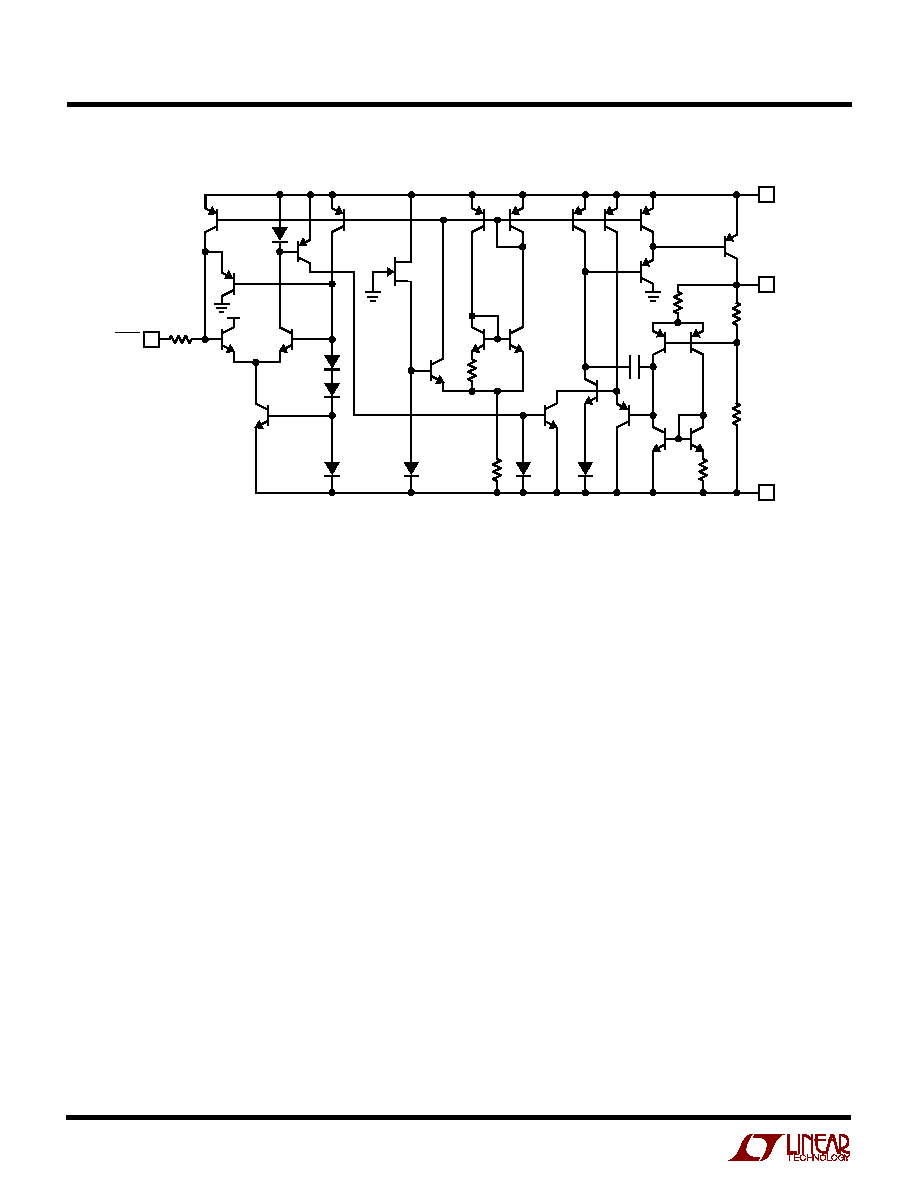
14
LT1461
SI PLIFIED SCHE ATIC
W
W
4 GND
1461 SS
6 V
OUT
3
SHDN
100k
2 V
IN
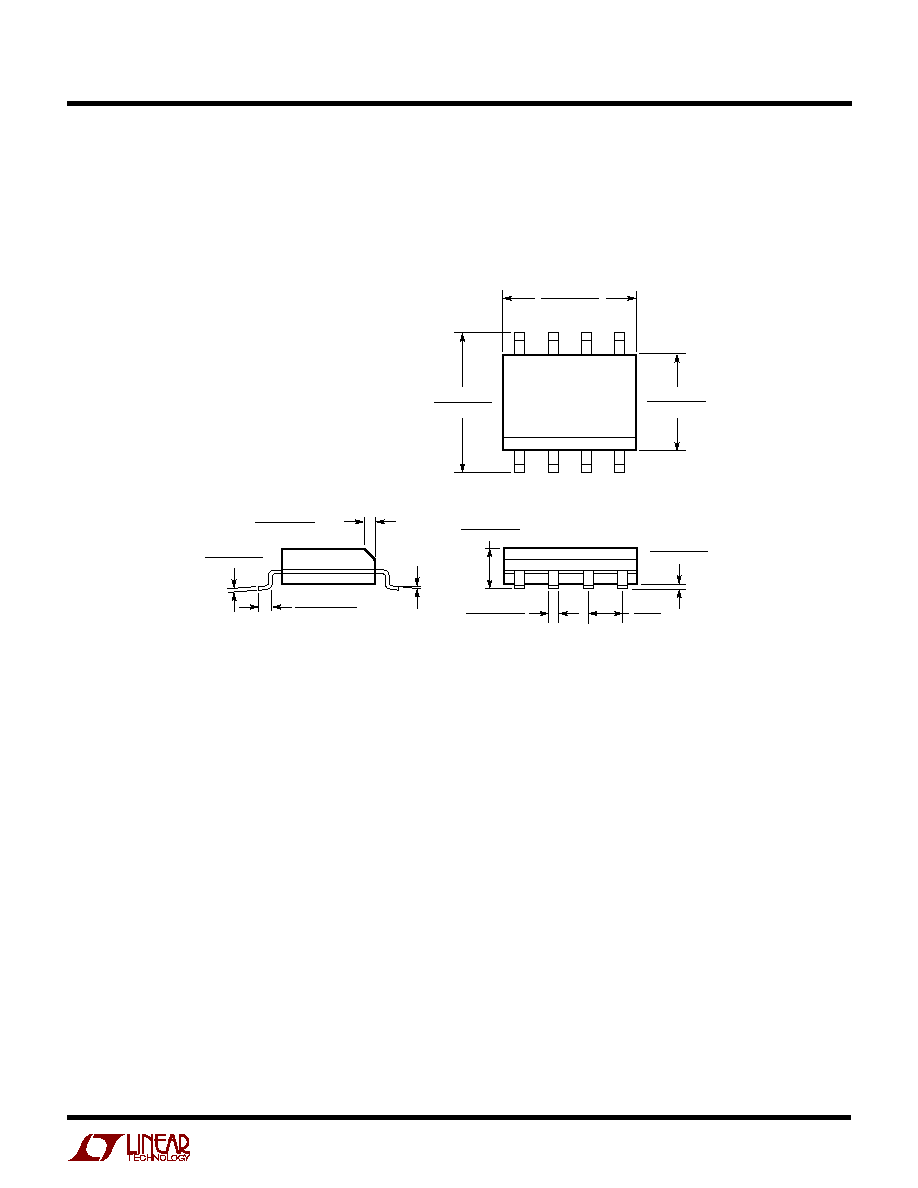
15
LT1461
Dimensions in inches (millimeters) unless otherwise noted.
S8 Package
8-Lead Plastic Small Outline (Narrow 0.150)
(LTC DWG # 05-08-1610)
0.016 ≠ 0.050
(0.406 ≠ 1.270)
0.010 ≠ 0.020
(0.254 ≠ 0.508)
◊
45
∞
0
∞
≠ 8
∞
TYP
0.008 ≠ 0.010
(0.203 ≠ 0.254)
SO8 1298
0.053 ≠ 0.069
(1.346 ≠ 1.752)
0.014 ≠ 0.019
(0.355 ≠ 0.483)
TYP
0.004 ≠ 0.010
(0.101 ≠ 0.254)
0.050
(1.270)
BSC
1
2
3
4
0.150 ≠ 0.157**
(3.810 ≠ 3.988)
8
7
6
5
0.189 ≠ 0.197*
(4.801 ≠ 5.004)
0.228 ≠ 0.244
(5.791 ≠ 6.197)
DIMENSION DOES NOT INCLUDE MOLD FLASH. MOLD FLASH
SHALL NOT EXCEED 0.006" (0.152mm) PER SIDE
DIMENSION DOES NOT INCLUDE INTERLEAD FLASH. INTERLEAD
FLASH SHALL NOT EXCEED 0.010" (0.254mm) PER SIDE
*
**
U
PACKAGE DESCRIPTIO
Information furnished by Linear Technology Corporation is believed to be accurate and reliable.
However, no responsibility is assumed for its use. Linear Technology Corporation makes no represen-
tation that the interconnection of its circuits as described herein will not infringe on existing patent rights.

16
LT1461
1461f LT/LCG 0800 4K ∑ PRINTED IN USA
©
LINEAR TECHNOLOGY CORPORATION 1999
Linear Technology Corporation
1630 McCarthy Blvd., Milpitas, CA 95035-7417
(408) 432-1900
q
FAX: (408) 434-0507
q
www.linear-tech.com
PART NUMBER
DESCRIPTION
COMMENTS
LT1019
Precision Reference
Bandgap, 0.05%, 5ppm/
∞
C
LT1027
Precision 5V Reference
Lowest TC, High Accuracy, Low Noise, Zener Based
LT1236
Precision Reference
5V and 10V Zener-Based 5ppm/
∞
C, SO-8 Package
LTC
Æ
1798
Micropower Low Dropout Reference
0.15% Max, 6.5
µ
A Supply Current
LT1460
Micropower Precision Series Reference
Bandgap, 130
µ
A Supply Current 10ppm/
∞
C, Available in SOT-23
LT1634
Micropower Precision Shunt Voltage Reference
Bandgap 0.05%, 10ppm/
∞
C, 10
µ
A Supply Current
LT1790
Precision SOT-23 Series Reference
Bandgap 0.05% Max, 10ppm/
∞
C Max
RELATED PARTS
SCK
SD0
CS
NOISE PERFORMANCE*
V
IN
= 0V, V
NOISE
= 1.1ppm
RMS
= 2.25
µ
V
RMS
= 16
µ
V
P-P
V
IN
= V
REF
/2, V
NOISE
= 1.6ppm
RMS
= 4
µ
V
RMS
= 24
µ
V
P-P
V
IN
= V
REF
, V
NOISE
= 2.5ppm
RMS
= 6.25
µ
V
RMS
= 36
µ
V
P-P
*FOR 24-BIT PERFORMANCE USE LT1236 REFERENCE
V
REF
V
CC
200
µ
A
35
µ
A
1
µ
F
1461 TA03
0.1
µ
F
1
µ
F
F
O
LTC2400
V
CC
GND
LT1461-2.5
V
CC
V
OUT
INPUT
GND
V
IN
SPI
INTERFACE
Low Power 16-Bit A/D
U
TYPICAL APPLICATIO















